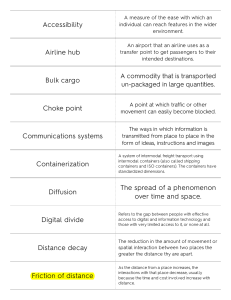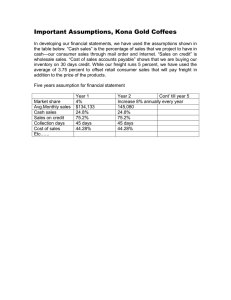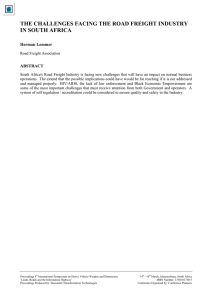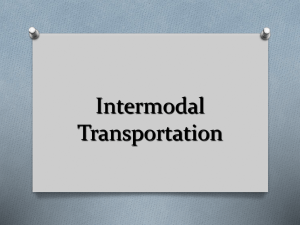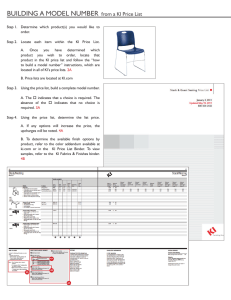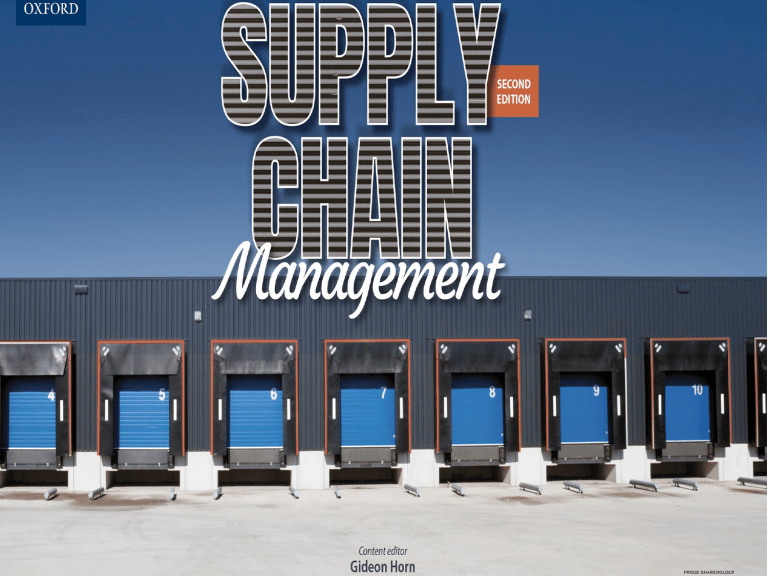
Chapter Four Inbound transportation Learning objectives • Understand the place of transportation in the supply chain • Describe the how transportation is influenced by the supply chain management approach • Identify the steps in implementation of an inbound transportation management system • Identify the various modes of transport and recognise their applicability in different situations • Discuss intermodal transport. • Discuss containerisation. • Discuss the legal forms in transportation • Discuss the internal movement of materials 4.1 Introduction Materials in various stages of processing flow through a supply chain: • materials flow from suppliers to the organisation (inbound transportation), • within the organisation between processes (materials flow) and • out of the organisation to the next partner in the supply chain, • or the final customer if the organisation is a retailer. Transportation is a link between customers, suppliers, factories, warehouses and the individual participants in a supply chain Introduction (cont) Transportation adds value to organisation by creating time and place utility for products • Place utility: achieved when right product is available at right place • Time utility: when the product is available at the right time. Important in overall customer satisfaction – main objective of SCM Introduction (cont) • Many decisions and activities in transportation: • the mode of transport • specific carrier • determining transportation terms and prices • aligning inbound and outbound flows to ensure optimal utilisation of transport equipment and rating the carrier’s performance • planning supply routes • classifying freight • determining the most economical quantities of consignments • pooling freight, auditing freight invoices, claiming damaged goods • in-plant and interplant movement 4.2 Importance of the management of transport in SCM • Ensures that products or materials are received on time at required place and in usable condition • Managing large costs involved • Transportation is a key component of SCM. • Transportation plays key integrative role – to integrate and coordinate flows throughout supply chain • Transportation system becomes the warehouse - orders consolidated by computer and carriers coordinated for JIT deliveries • Good transportation system enables achieving competitive advantage – satisfying customer needs faster and at lower cost 4.3 Managing inbound transportation key-leverage points Volume per transaction: buying larger amounts of product per transaction to get the best transportation rate Consolidation of carriers and movements: Service requirements : to gain best rate possible through negotiations with transportation suppliers lead times and delivery requirements related to specific times and/or expedited movements for shorter cycle times Managing inbound transportation • Clark (2018) suggests 10 steps a business can take to start managing its inbound freight more effectively: 1. Partner with your suppliers to lay out a plan of action. 2. Implement a standard routing guide for supplier compliance. 3. Consolidate inbound shipments to full truckload whenever possible. 4. Create strong alliances with your carriers. 5. Implement a dynamic rate allowance program for freight costs. 6. Implement a set of automated Vendor Inbound Compliance Standards (VICS) to change supplier behavior. 7. Establish penalties for violators of compliance. 8. Implement deduct-from-invoice (DFI) capability with your ERP. 9. Implement a supplier portal system to improve communication and collaboration with suppliers. 10. Capture analytics to measure savings and find additional areas for improvement. 4.4 Modes of transport Rail Shipping • not so extensive as road • critical for transportations of high volumes over long distances • Fundamental part in international supply chain • Transporting large quantities/mass Pipelines • Transporting gas, crude oil, petroleum products, petrol, diesel, water & chemicals Road • Relatively fast • More expensive than rail • Increased risks • Strict legal requirements • Extra-heavy freight transport difficult • Dominant due to: • Flexible and adaptable service requirements • JIT and QR service • Time-dependable and safe service Other Air freight • Limited to low mass, low volume and high value • High speed • Key element in international supply chain • courier services, mini containers & parcel post Intermodal transport • Using more than one mode in combination 4.5 Intermodal transportation • Intermodal transport means that two or more modes of transport or carriers are used to trans-port goods (freight) from shipper (supplier) to consignee (buyer). • For intermodal transport, using for example trucks, freight trains, and ships, special, standardised containers are used. • The standardised containers are necessary for not handling the goods during the changeover from one means of transport to another. • With intermodal transport, a decision will have to be made by considering the cost and/or service advantages of two or more modes for a single consignment. 4.6 Containerisation • Containerisation is a shipping method in which a large amount of material (such as merchandise) is packaged into large standardised containers. • Containerisation is a system of intermodal freight transport using intermodal containers. • The containers are ISO standardised and can be transferred with standardised handling equipment between ships, trains, and trucks, without re-handling the contents. 4.7 Transportation terms Incoterms • Transport terms will affect the price of the purchased goods • Transport terms has cost, risk and legal implications • Incoterms (International Commercial Terms) is usually consulted when a decision is made on the transportation terms - accepted as the authoritative source of reference for transport terms. • These terms can be used for both overseas and domestic transactions. • See table 4.1 for a summary of incoterms Transportation terms - Incoterms Code Name of term Any mode of transport EXW Ex works FCA Free carrier CPT Carriage paid to CIP Carriage and insurance paid to DAT Delivered at terminal DAP Delivered at place DDP Delivered duty paid Sea and inland waterway transport only FAS Free alongside ship FOB Free on board CFR Cost and freight CIF Cost, insurance and freight 4.8 Internal transportation of materials • Known as ‘materials handling’ • Does not add to the value of the product, but may be a major cost component (2% of value of stock) – add place value • Defined as the short-dis­tance movement and handling of materials which usually takes place within the limits of a building (storehouse) or other inventory storage facility, with a view to maximum service and minimum cost. • Takes place at: • the loading and unloading from vehicles; • the movement to storage before processing or assembly; • the movement of material between work stations; • the movement to warehouses of the finished goods and the uploading on vehicles Principles of internal movement • Transport should be eliminated or transport distances should be shortened (the principle of distance) • Materials flow should not be interrupted unnecessarily • Materials should be moving or decrease the time material is located at various points (the principle of flow) • Easy routes should be planned and the backwards movement of materials should be eliminated (the principle of layout) • Transport should take place in both directions, thus the movement of empty containers should be limited (the principle of occupation) • Economical quantities should be transported or use smaller containers (the principle of capacity utilisation) • Gravity or an alternative cheap and reliable source of power should be used for movement of materials.
